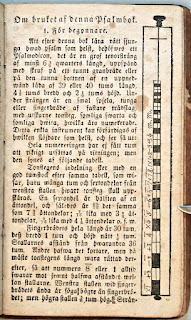Hedlund came to the United States from Gafleborgs län as a boy in 1850, married in 1876 and farmed 115 acres in Galva Township. An independent in politics, he was a Christian ("tror på kristendomen") but was not a member of any church (tillhör ingen kyrka), according to Svenskarne i Illinois (Chicago, 1880) by Eric Johnson. [Link here for the full text at archive.org.] Judging by the instrument on display in Bishop Hill, he was an accomplished woodworker.
The fretboard is 28" in length. The frets are chromatic, but the patterns of lighter and darker wood -- white and black in the diagrams in Johan Dillner's introduction to the 1846 sifferskrift (psalmodikon tablature) edition of Johan Olof Wallin's Swedish Psalmbook of 1819 -- indicate diatonic scales. The heading in the picture at left above reads, "Om bruket af denna Psalmbok" [on the use of this psalmbook]. Basically, you would play the intervals marked by the white frets.
To change keys, you apparently retuned the instrument.
To see how Dillner's introduction to the 1846 edition compares to the Bishop Hill psalmodikon, pictured at right below, orient yourself as follows:
- The nut and tuning peg on the left-hand end of the instrument in picture, at right below, are pictured at the bottom of the diagram, at left above; and
- The bridge is on the right-hand end of the instrument in the picture and the top of the diagram, indicated by a line perpendicular to the playing string.
Dillner doesn't call for a violin-style tailpiece like that on the Bishop Hill psalmodikon. The bridge on the Bishop Hill instrument is moveable.
Dimensions
I've taken pictures of the instrument twice, once in 2008 not long after I first saw it in the Steeple Building and again this year when I decided to have a replica made. I didn't want to take the instrument out of its case, since the tailpiece and bridge had fallen off in the meantime. So I photographed it in the museum case and my measurements are approximate. It is shaped like an elongated trapezoid 39" x 5.5" (at the nut end, to the left in the picture above) x 7.5" (at the bridge end, to the right). The soundbox is 2.25" deep; the nut end is roughly 5.5" x 3" (but the end piece is irregular in order to accommodate the raised fretboard). The picture at right above was taken in 2008, when the bridge and tailpiece were still attached to the instrument.
My measurements correspond very closely to those in Dillner's introduction, although the units of measurement are not exactly the same.
Dillner gives the following dimensions:
- Length: 39 or 40 tums.
- Breadth: 4.5 tums.
- Height: 2/5 tums.
- Fretboard: 30 tums.
Construction (misc. notes)
Bridge and tailpiece are similar to a fiddle. Since 2008 when I first took pictures of the instrument, they have fallen off. But at that time the tailpiece was apparently attached to the body with string (please see picture below), and the bridge was held in place by the downward tension of the playing string, which at that time was still attached, although it appears from the picture below that the string was loose and the bridge had moved out of position.
I am not sure how the tailpiece was attached to the instrument originally, but I suspect it was more substantial than what I saw in 2008. Since that time, the string has come off that end of the psalmodikon and the nut and bridge are lying beside it in the display case.
The instrument was tuned by a peg attached to the nut end. To play in a different key, you retuned the instrument. The tunings are related to the old ecclesiastical modes -- i.e. ionian, dorian, etc. (see diagram "Tabell öfwer kyrko-tonarterna" [table of church modal scales] below. The patterns of darker and lighter wood mark off sharps and flats in much the same way as the black and white keys on a piano, and the different modes have different intervals indicated by the numbers, pluses and minuses on the table.
The soundholes are especially nice, suggesting a stylized lyre. See detail below:
No time to look this up now, but it looks interesting and I don't want to lose it. Has pix of several psalms from Wallin 1819 in sifferskrift ...
Psalmodikon var musikintrumentet i många kyrkor och skolor Infört under juli 2002 i Lysekilsposten och Stenungsunds-Posten med Orust-TjörnPart I at http://svenhgullman.nu/oevrigt/psalmodikon1.htm and Part II at http://svenhgullman.nu/oevrigt/psalmodikon2.htmBy Sven H. Gullman




No comments:
Post a Comment